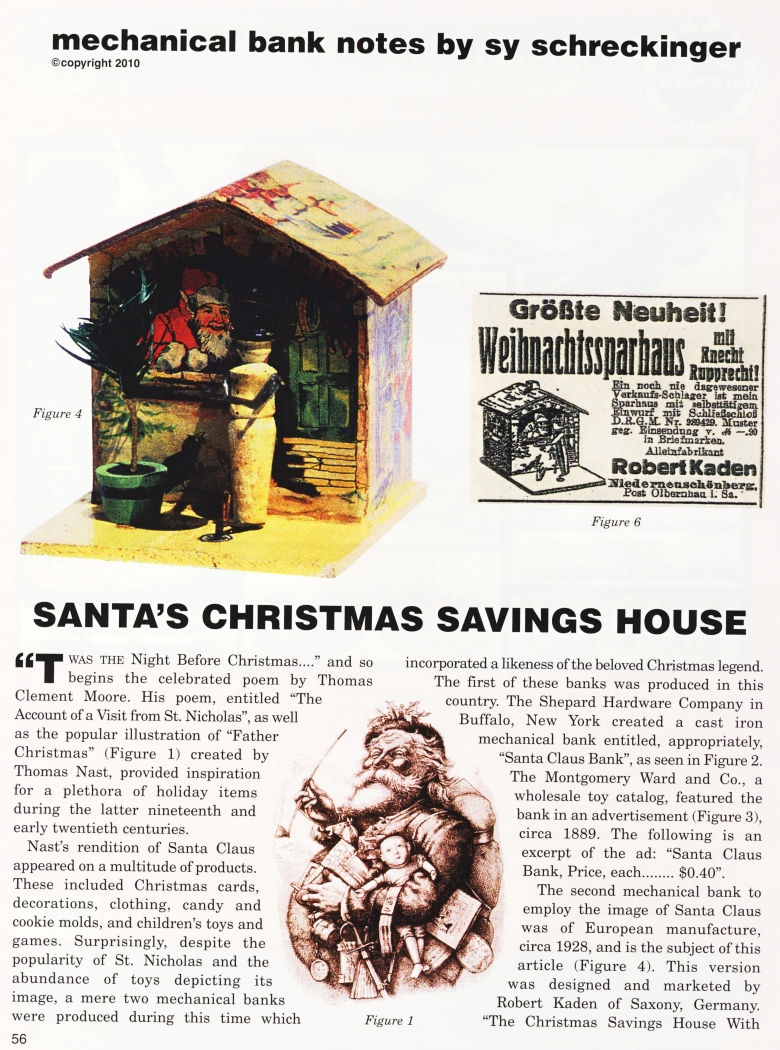|
Santa's Christmas Savings House
by Sy Schreckinger – ANTIQUE TOY WORLD Magazine – December, 2010
"TWAS
THE Night Before Christmas...." and so begins the celebrated poem by
Thomas Clement Moore. His poem, entitled "The Account of a Visit from
St. Nicholas", as well
as the popular illustration of "Father Christmas" (Figure 1) created by
Thomas Nast, provided inspiration for a plethora of holiday items during
the latter nineteenth and early twentieth centuries.
Nast's rendition of Santa Claus appeared on a multitude of products.
These included Christmas cards, decorations, clothing, candy and cookie
molds, and children's toys and games. Surprisingly, despite the
popularity of St. Nicholas and the abundance of toys depicting its
image, a mere two mechanical banks were produced during this time which
incorporated a likeness of the beloved Christmas legend.
The first of these banks was produced in this country. The Shepard
Hardware Company in
Buffalo, New York created a cast iron
mechanical bank entitled, appropriately,
"Santa Claus Bank", as seen in Figure 2.
The Montgomery Ward and Co., a
wholesale toy catalog, featured the
bank in an advertisement (Figure 3),
circa 1889. The following is an
excerpt of the ad: "Santa Claus
Bank, Price, each $0.40".
The second mechanical bank to
employ the image of Santa Claus
was of European manufacture,
circa 1928, and is the subject of this article (Figure 4). This version
was designed and marketed by
Robert Kaden of Saxony, Germany. "The Christmas Savings House With
Santa Claus" is one of a series of five known mechanicals of similar
design, composition and construction. Each utilizes a carved or turned
wood, movable figure adjoining a colorfully lithographed cardboard
edifice. Other members of the group include "Easter Bunny Cottage Bank",
"Woman Cottage Bank". "Woman With Dog Cottage Bank" and "Ybarra Olive
Oil Cottage Bank".
"Christmas Savings House", as well as its brethren, was produced in
Saxony, Germany during the early twentieth century. Its lineage was
gleaned from the letters "D.R.G.M. 989429" printed upon the rear
section of the bank. Figure 5 is a t copy of an early German Patent
Paper indicating our subject's date of registration as "April 27, 1927. Designed by
Robert Kaden and Emil Kaden of Saxony, Germany". It also describes the
bank
as "having a movable figure, and being composed of sturdy cardboard." In addition. the aforementioned
patent refers to "an expiration date of June 20, 1930".
The discovery of an advertisement within an issue of the German
newspaper "Der Globus" (Figure 6), circa 1928, was also quite
informative. The translation from German into English reads as follows:
"Biggest Novelty! Christmas Savings House with Santa Claus! This is the
latest and biggest selling hit. My Savings House with automatic coin
slot and key lock. D.R.G.M 989429. For sample send 0.90 Mark in stamps.
Robert Kaden exclusive manufacturer, Niederneuschonberg, Post Office
Olbemhau in Saxony".
Of interest and worthy of mention is the circumstance that possibly led
to the creation of the cottage / house series of mechanicals. During this
time, a cottage/home-based industry was flourishing in the Erzgebirge
mountain region of Germany. Here, entire families were engaged in the
carving, turning and hand painting of small, whimsical wooden figures.
These were ultimately supplied to local toy manufacturers and
distributors (e.g. Robert Kaden). Because of their simplicity of
construction, the cost for figurines was extremely reasonable, enabling
distributors and/or manufacturers to incorporate them into their own
inexpensive holiday goods and seasonal novelty items. "Christmas Savings
House" seen in Figure 4 is an example of one such composite. Represented
is an Erzgebirge-carved wooden figure of a snowman, together with a
lithographed, cardboard building manufactured by Robert Kaden.
Operation of "Christmas Savings House" is simplistic and amusing. A coin
is placed in the snowman's tin tray. Its added weight causes the figure
to rotate towards the right side, resulting in deposition of the coin
through the designated slot in the front of the cottage. Monies are
recovered by opening a tin, key lock, trap door type coin retainer in
the rear of the building.
"Christmas Savings House with Santa Claus" is considered quite rare. A
mere three examples are known to exist. Despite its simplistic, modest
construction and miniscule size (Height: 4 inches. Width: 3-3/8 inches.
Depth: 2-5/16 inches), "Christmas Savings House" is an extremely
attractive and important addition to a mechanical bank collection.
To conclude. Figure 7 indicates a variation of "Christmas Savings
House". In place of the potted Christmas tree seen in Figure 4, a small
Erzgebirge-carved wooden dog is positioned alongside the figure of the
snowman.
Acknowledgement: Copies of the German Patent Document (Figure 5). the Robert Kaden
advertisement (Figure 6A and their translation were generously provided
by fellow collectors and historians, Harald and Uli Merklein of
Nurnberg, Germany. |


